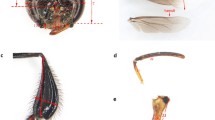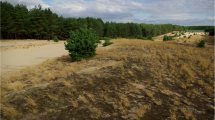Abstract
Tetragonisca angustula and T. fiebrigi are morphologically similar and differentiated mainly by the mesepisternum color, black in the former and ferruginous in the latter. Mixed mesepisternum color on some bees has raised discussions about the taxonomic status of these species if some degree of hybridization can occur between them and they should be regarded as subspecies. Our goal was to investigate if T. angustula and T. fiebrigi are two valid species and contribute to their taxonomic identification. We sampled several colonies from distant Brazilian regions (range of 3,000 km) to analyze the mesepisternum color variation of males and workers, genitalia morphology of males and females (queens and workers), and aggressiveness of the workers in both species. Despite some color variations in some colonies, there are always individuals with typical mesepisternum color inside each colony, i.e., black in T. angustula and ferruginous in T. fiebrigi. The fact that both T. angustula and T. fiebrigi males have black mesepisternum could be causing species misclassifications. The genitalia morphology of males (shape and length of gonostylus and penis valve) and females (gonostylus shape) was consistently different between both species. None of the analyzed male aggregations exhibited mixed males of T. angustula and T. fiebrigi, which indicates that the queen attracts only co-specific males. Tetragonisca angustula workers displayed an aggressive behavior, whereas T. fiebrigi workers were unaggressive. The observed morphological and behavioral differences may be indicators of reproductive isolation between the two species. Therefore, we conclude that T. angustula and T. fiebrigi are two valid species.






Similar content being viewed by others
Data availability
Not applicable.
References
Attasopa K, Banziger H, Disayathanoowat T, Packer L (2018) A new species of Lepidotrigona (Hymenoptera: Apidae) from Thailand with the description of males of L. flavibasis and L. doipaensis and comments on asymmetrical genitalia in bees. Zootaxa 4442(1):63–82
Batista MA, Ramalho M, Soares AE (2003) Nesting sites and abundance of Meliponini (Hymenoptera: Apidae) in heterogeneous habitats of the Atlantic Rain Forest, Bahia. Brazil Lundiana: Int J Biodiver 4(1):19–23
Bueno FGB, Santos CF, Otesbelgue A, Menezes C, van Veen J, Blochtein B, Gloag R, Heard T, Imperatriz-Fonseca VL, Alves DA (2023) The queens of the stingless bees: from egg to adult. Insectes Soc 70:43–57
Camargo JMF, Pedro SRM, Melo GAR (2023) Meliponini Lepeletier, 1836. In: Moure JS, Urban D, Melo GAR (eds) Catalogue of Bees (Hymenoptera, Apoidea) in the Neotropical Region - online version. http://www.moure.cria.org.br/catalogue . Accessed 25 Sep 2023
Camargo JM, Moure JS (1994) Meliponinae neotropicais: os gêneros Paratrigona Schwarz, 1938 e Aparatrigona Moure, 1951 (Hymenoptera, Apidae). Arq Zool 32(2):33–109
Camargo JM, Moure JS (1996) Meliponini neotropicais: o gênero Geotrigona Moure, 1943 (Apinae, Apidae, Hymenoptera), com especial referência à filogenia e biogeografia. Arq Zool 33(2–3):95–161
Cane JH (1987) Estimation of bee size using intertegular span (Apoidea). J Kansas Entomol Soc 60(1):145–147
Carvalho AF (2022) Illegalities in the online trade of stingless bees in Brazil. Insect Conserv Divers 15(6):673–681
Carvalho-Zilse GA, Silva CGN, Alves RMDO, Souza BDA, Waldschmidt AM, Carvalho CAL (2011) Meliponicultura: perguntas mais frequentes sobre abelhas sem ferrão-I. Série Meliponicultura número 08, Bahia, Brazil
Castanheira EB, Contel EP (1995) Isoenzymes related to flight activity in Tetragonisca angustula (Hymenoptera: Apidae: Meliponinae): Evidence of postranslational modification of the hexokinase and detection of new glycerol-3-phosphate dehydrogenase variants. Biochem Genet 33(11):365–375
Castanheira EB, Contel EPB (2005) Geographic variation in Tetragonisca angustula (Hymenoptera, Apidae, Meliponinae). J Apic Res 44(3):101–105
Eberhard WG (2010) Evolution of genitalia: theories, evidence, and new directions. Genetica 138(1):5–18
Eickwort KR (1969) Differential variation of males and females in Polistes exclamans. Evolution 23(3):391–405
Francisco FO, Santiago LR, Brito RM, Oldroyd BP, Arias MC (2014) Hybridization and asymmetric introgression between Tetragonisca angustula and Tetragonisca fiebrigi. Apidologie 45:1–9
Kerr WE, Zilse GAC, Nascimento VA (1996) Abelha uruçu: biologia, manejo e conservação. Fundação Acangaú, Brazil
Koedam D, Velthausz PV, KRIFT, T. V., Dohmen, M. R., Sommeijer, M. J. (1996) Morphology of reproductive and trophic eggs and their controlled release by workers in Trigona (Tetragonisca) angustula llliger (Apidae, Meliponinae). Physiol Entomol 21(4):289–296
Koedam D, Brone M, Van Tienen PGM (1997) The regulation of worker-oviposition in the stingless bee Trigona (Tetragonisca) angustula Illiger (Apidae, Meliponinae). Insectes Soc 44:229–244
Koling DF, Moretto G (2010) Mitochondrial discrimination of stingless bees Tetragonisca angustula (Apidae: Meliponini) from Santa Catarina state. Brazil Apidologie 41(4):454–462
Kulza RA, Galhardo D, Moreira DR, Gigliolli AAS, Santos SA, Toledo VDAA, Ruvolo-Takasusuki MCC (2022) Analysis of the population structure of Tetragonisca (hymenoptera, meliponini) by microsatellite markers and network interactions. Res Soc Dev 11(4):e4711424811–e4711424811
Masly JP (2012) 170 years of “lock-and-key”: genital morphology and reproductive isolation. Int J Evol Biol 2012:247352
Michener CD (2007) Bee taxa and categories. In: Michener CD (ed) The Bees of the World, 2nd edn. The Johns Hopkins University Press, Baltimore, pp 66–75
Nogueira-Neto P (1997) Vida e criação de abelhas indígenas sem ferrão. Editora Nogueirapis, Brazil
Oliveira RDC, Nunes FDMF, Campos APS, Vasconcelos SMD, Roubik D, Goulart LR, Kerr WE (2004) Genetic divergence in Tetragonisca angustula Latreille, 1811 (Hymenoptera, Meliponinae, Trigonini) based on RAPD markers. Genet Mol Biol 27(2):181–186
Prato M, Soares AEE (2013) Production of sexuals and mating frequency in the stingless bee Tetragonisca angustula (Latreille) (Hymenoptera, Apidae). Neotrop Entomol 42:474–482
Rasmussen C, Skov C (2006) Description of a new species of Euglossa (Hymenoptera: Apidae: Euglossini) with notes on comparative biology. Zootaxa 1210(1):53–67
Roubik DW, Heard TA, Kwapong P (2018) Stingless bee colonies and pollination, in: Roubik, D.W. (Ed.), The pollination of cultivated plants: A compendium for practitioners. Volume 2. Smithsonian Tropical Research Institute, 39–64
Santos SA, Bronzato AR, Moreira BMT, Araujo KF, Ronqui L, Mangolin CA, Toledo VAA, Ruvolo-Takasusuki MCC (2015) Matrilineage differentiation of the genus Tetragonisca using mitochondrial DNA markers and the polymerase chain reaction-restriction fragment length polymorphism. Genet Mol Res 14(4):12828–12840
Santos CF, Imperatriz-Fonseca VL, Arias MC (2016) Relatedness and dispersal distance of eusocial bee males on mating swarms. Entomol Sci 19(3):245–254
Schilthuizen M (2003) Shape matters: the evolution of insect genitalia. Proc Exper Appl Entomol NEV 14:9–16
Schwarz HF (1938) The stingless bees (Meliponidae) of British Guiana and some related forms. Bull Am Mus Nat Hist 74:437–508
Shackleton K, Alves DA, Ratnieks FL (2018) Organization enhances collective vigilance in the hovering guards of Tetragonisca angustula bees. Behav Ecol 29(5):1105–1112
Stuchi ALPB, de Toledo VDAA, Lopes DA, Cantagalli LB, Ruvolo-Takasusuki MCC (2012) Molecular marker to identify two stingless bee species: Tetragonisca angustula and Tetragonisca fiebrigi (Hymenoptera, Meliponinae). Sociobiology 59(1):123–134
Viraktamath S, Roy J (2022) Description of five new species of Tetragonula (Hymenoptera: Apidae: Meliponini) from India. Biologia 77(7):1769–1793
Vossler FG (2012) Flower visits, nesting and nest defence behaviour of stingless bees (Apidae: Meliponini): suitability of the bee species for meliponiculture in the Argentinean Chaco region. Apidologie 43:139–161
Acknowledgements
The authors wish to thank all the beekeepers that kindly opened their jataí colonies for our sampling.
Funding
“Conselho Nacional de Desenvolvimento Científico e Tecnológico (CNPq) (research grant number 3064Z86/ 2019-9 to JLN)”, “Coordenação de Aperfeiçoamento de Pessoal de Nível Superior (CAPES)”, and “Fundação de Amparo à Pesquisa do Estado de Minas Gerais (FAPEMIG)” provided financial support.
Author information
Authors and Affiliations
Contributions
Study conception and design: MSC, LAOC, and JLN. Data collection and analyzes: MSC, MR, and JLN. Supervision: LAOC. Literature review and first draft of the manuscript: MSC. All authors commented on previous versions and approved the final manuscript.
Corresponding authors
Ethics declarations
Ethical approval
Not applicable.
Code availability
Not applicable.
Consent to participate
Not applicable.
Consent for publication
Not applicable.
Conflict of interest
The authors declare no competing interests.
Additional information
Manuscript editor: Marina Meixner
Publisher's Note
Springer Nature remains neutral with regard to jurisdictional claims in published maps and institutional affiliations.
Supplementary Information
Below is the link to the electronic supplementary material.
Rights and permissions
Springer Nature or its licensor (e.g. a society or other partner) holds exclusive rights to this article under a publishing agreement with the author(s) or other rightsholder(s); author self-archiving of the accepted manuscript version of this article is solely governed by the terms of such publishing agreement and applicable law.
About this article
Cite this article
Cunha, M.S., Ronnau, M., Campos, L.A.O. et al. Morphological differences between Tetragonisca angustula and Tetragonisca fiebrigi (Apidae: Meliponini). Apidologie 55, 20 (2024). https://doi.org/10.1007/s13592-024-01062-y
Received:
Revised:
Accepted:
Published:
DOI: https://doi.org/10.1007/s13592-024-01062-y




